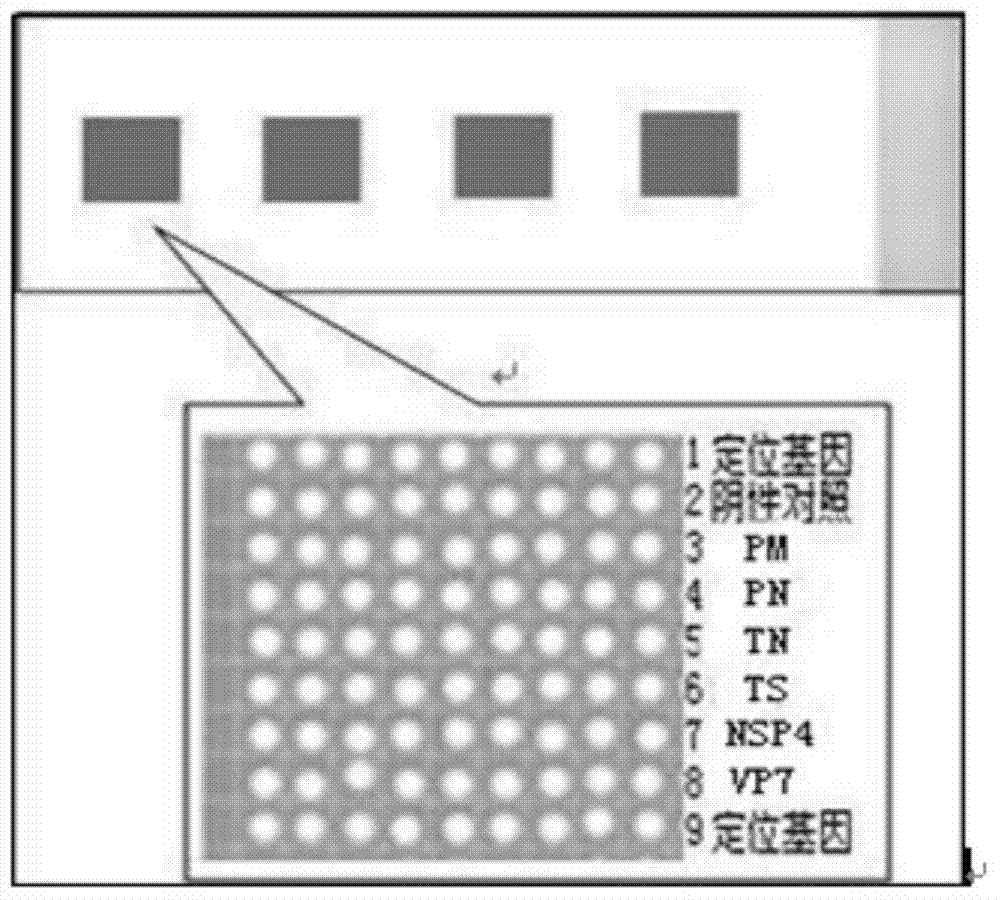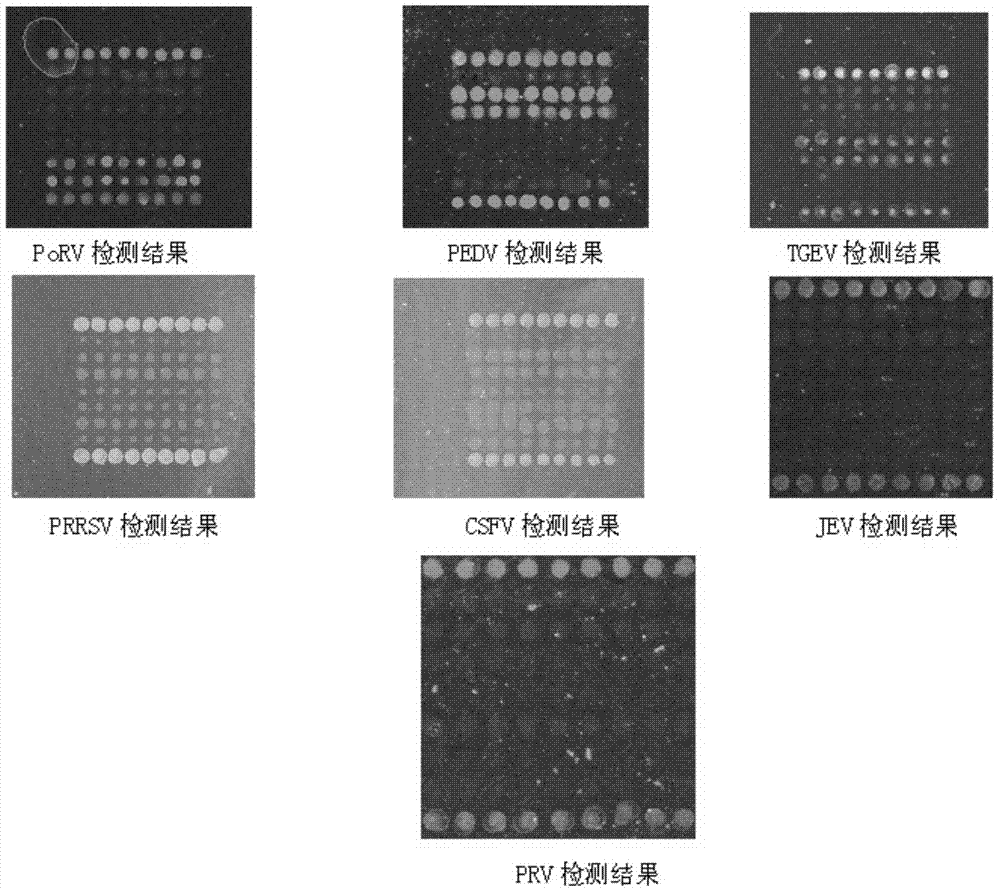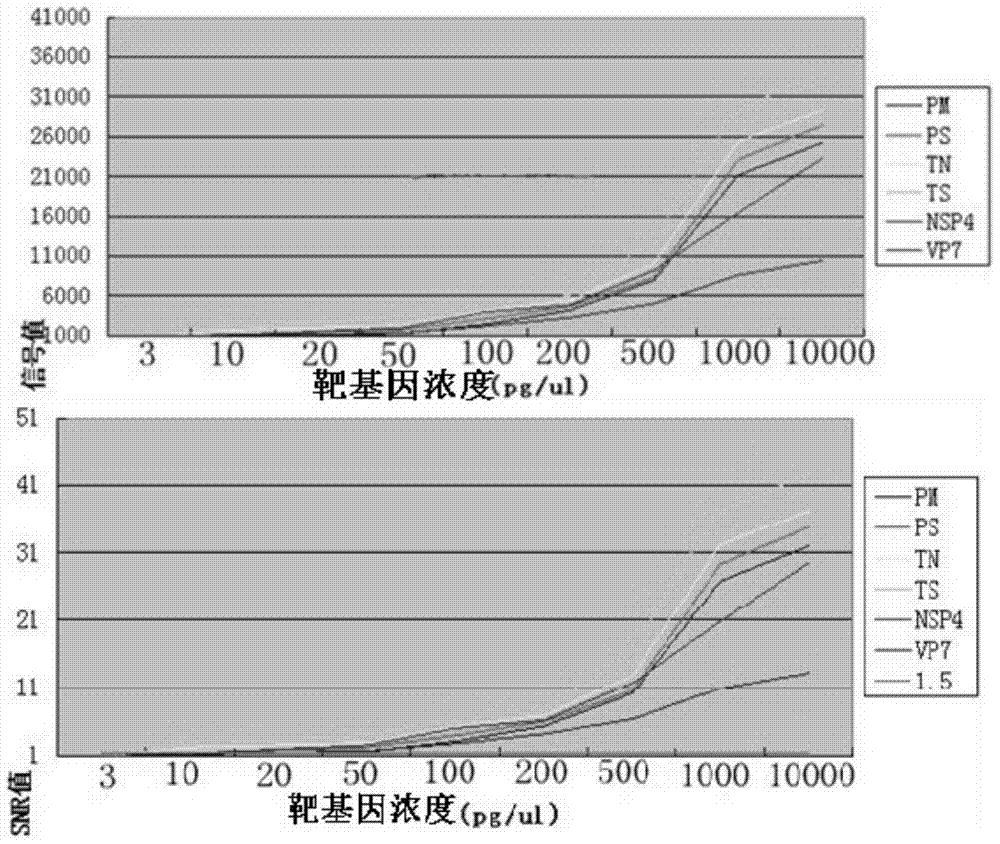Kit for detecting porcine epidemic diarrhea virus, porcine transmissible gastroenteritis virus and porcine rotavirus
A porcine epidemic diarrhea and porcine rotavirus technology, applied in the direction of microbe-based methods, biochemical equipment and methods, and microbiological determination/testing, can solve the problem of undisclosed gene chips and undisclosed detection of porcine epidemic diarrhea virus For issues such as transmissible gastroenteritis virus and porcine rotavirus, it has achieved strong specificity, good application prospects, and rapid detection results
- Summary
- Abstract
- Description
- Claims
- Application Information
AI Technical Summary
Problems solved by technology
Method used
Image
Examples
Embodiment 1
[0049] Embodiment 1 Preparation of kit of the present invention
[0050] 1. Materials and instruments
[0051] The same experimental materials and instruments as mentioned above.
[0052] 2. Experimental method
[0053] 2.1 Preparation of PCR primers and detection probes
[0054] (1) Design pathogen-specific probes: through the alignment analysis of the nucleic acid sequences of porcine epidemic diarrhea virus, porcine transmissible gastroenteritis virus, and porcine rotavirus included in GenBnak, the sequence of the conserved region was selected: PEDV M , S; TGEV N, S; PoRV NSP4, VP7. Design and detect multiple pairs of probes for conserved sequences, and select the probe sequences with strong specificity.
[0055] (2) Design of specific primers for probe sequences: specific primers were designed for the above conserved probe sequences using bioinformatics software DNAman, Primer5.0, etc. Specific primers were synthesized by Shanghai Bioengineering Company.
[0056] (3)...
Embodiment 2
[0120] Embodiment 2 The usage method of kit of the present invention
[0121] 1. Nucleic acid extraction
[0122] Extraction of viral RNA: The kit method is used to extract viral RNA, and the test uses a small amount of virus / liquid sample RNA extraction kit. Extract RNA according to the instructions of the kit, the method is as follows:
[0123] a) Take 300 μL of the sample to be tested and place it in a centrifuge tube, add 500 μL of RV solution, shake vigorously for 2 minutes, and then let stand at room temperature for 5 minutes.
[0124] b) Add 750 μL of isopropanol and shake gently.
[0125] c) Pipette 800 μL into the adsorption column and centrifuge at 12000 rpm for 30 s at 4°C.
[0126] d) Discard the liquid in the collection tube, transfer the remaining lysate into an adsorption column, and centrifuge at 12000r for 30s at 4°C.
[0127] e) Add 500 μL RP solution after discarding the collected solution, and centrifuge at 12000 rpm for 30 seconds at 4°C to remove prot...
Embodiment 3
[0147] Embodiment 3 specificity test
[0148] 1. Test method
[0149] Adopt the kit of embodiment 1, according to the method for embodiment 2, detect PoRV, TGEV, PEDV, PRRSV (porcine reproductive and respiratory syndrome virus), CSFV (swine fever virus), JEV (porcine Japanese encephalitis virus), PRV (porcine pseudorabies virus) 7 kinds of viruses, to verify the specificity of the kit of the present invention.
[0150] 2. Results
[0151] Experimental results such as figure 2 As shown, the inventive method can effectively detect PoRV, TGEV, PEDV of the present invention, and can not detect other virus, as, PRRSV, CSFV, JEV, PRV, shows that the specificity of the inventive method is strong, can not amplify other viruses. Virus.
PUM
 Login to View More
Login to View More Abstract
Description
Claims
Application Information
 Login to View More
Login to View More - R&D
- Intellectual Property
- Life Sciences
- Materials
- Tech Scout
- Unparalleled Data Quality
- Higher Quality Content
- 60% Fewer Hallucinations
Browse by: Latest US Patents, China's latest patents, Technical Efficacy Thesaurus, Application Domain, Technology Topic, Popular Technical Reports.
© 2025 PatSnap. All rights reserved.Legal|Privacy policy|Modern Slavery Act Transparency Statement|Sitemap|About US| Contact US: help@patsnap.com



